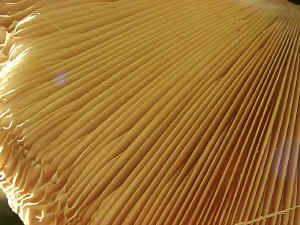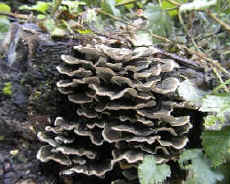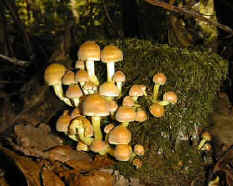|
Types of Fungi
Introduction
There are literally thousands of
different kinds of fungi. Two hundred thousand species have been identified world wide and
there are likely to be well over a million species.
We identify different species mostly
by the structure of their fruiting bodies and the arrangement and types of spores which
they produce.
There are a great many fungi
which are very small (microfungi). They will not be covered here. However, there
are many other fungi with large enough fruiting bodies to be easily seen.
There are over 3000 of these
larger fungi in Britain.
- Many fungi have fruiting bodies e.g. a mushroom which
are stalked. This helps to raise the spores some distance off the ground, so that when
they are released, they can easily catch wind currents and be carried to new places.
- Fruiting bodies of fungi will generally produce
millions of spores. A single fruiting body like a mushroom, may produce more than
10,000 million spores!
- Even though they are tiny, finding room for all these
spores on a relatively small fruiting body presents a major problem. The fruiting bodies
of fungi are therefore cleverly engineered to provide space for the production of enormous
numbers of spores, without having to produce an enormous fruiting body to accommodate them
all. Different types of fungi have accomplished this in different ways.
|
 |
Fungi such as
mushrooms, have hundreds of paper-thin folds, called gills, on the underside of the
mushroom cap. The spores are produced all over these gills, which provide an enormous
surface area base for the spores. Gills are sometimes also known as lamellae. |

|
Some other fungi have
small tubes or pores within the fruiting body. The
spores develop all over the inside of the pores, which again help to produce a large
surface area. |
| Still
other fungi have developed fruiting bodies covered with enormous numbers of tooth-like
structures which bear the spores. Others just have large numbers of folds all over
the fruiting body. All of these different methods for increasing surface area of the
fruiting body and the different structures which result, provide a useful way to identify
different kinds of fungi. |
Continue
|




